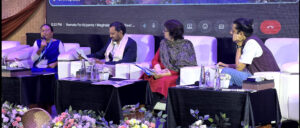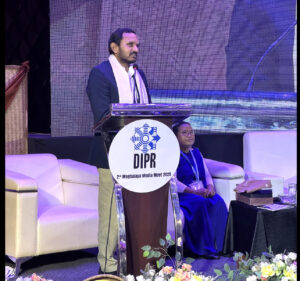At a recent panel discussion on “Telling Change, Not Just Stories: Building Media Capacities for Human-Centric Reporting,” Shri Sampath Kumar, IAS, Principal Secretary, Health and Family Welfare Department, Government of Meghalaya, shared deep insights on the power of media in shaping public understanding of governance and human development.
According to him, change is not merely about numbers — it is about people’s lives. Reporting, he emphasized, must go beyond statistics and schemes to reflect what interventions truly mean for mothers, children, and communities at the last mile. “The role of media is critical in bridging the citizen–state connection,” he said, “by showing what works, why it works, and how it impacts families.”

Reframing Meghalaya’s Governance Story
Sharing Meghalaya’s experience, Shri Kumar noted that there was a time when maternal deaths were seen as inevitable. “We chose to reframe them as solvable problems,” he said. Through the Rescue Mission and Village Health Councils (VHCs), Meghalaya has built a community-driven system that cut maternal deaths by 50% and infant deaths by 37% between 2021 and 2025.
“These outcomes were not the result of directives alone,” he added, “but of purpose-driven governance and strong community participation.” Frontline workers, ASHA facilitators, women’s groups, and local councils have been motivated to act as agents of transformation, supported by initiatives like the Human Development Learning Platform (HDLP) that strengthen last-mile delivery.
“The media,” he stressed, “can play a similar role — by shifting narratives from despair to solvability.”
Focusing on Process, Not Just Events
Shri Kumar urged journalists to focus on processes rather than isolated events, documenting how communities, institutions, and frontline workers collaborate to drive change.
He called for stories that highlight lived experiences — those of ASHA workers, mothers, youth, and SHG members — and to view development through a human development lens, where health, nutrition, education, and livelihoods are interconnected.
Highlighting the importance of local leadership, he observed that women-led VECs, SHGs, and village councils are shaping outcomes in tangible, often transformative ways. “These are not just implementers of government schemes,” he said, “but leaders redefining how development happens.”
Innovation and the Power of Storytelling
Underscoring the importance of innovation in reporting, Shri Kumar encouraged journalists to use data and storytelling together. He cited examples such as pairing dashboard data on reduced maternal deaths with a story of a village where a VHC’s swift action saved a mother’s life.
“This combination of evidence and empathy,” he explained, “makes stories both credible and deeply human.”
He also highlighted Meghalaya’s experiments with Payment for Ecosystem Services (PES) and Early Childhood Development (ECD) initiatives led by women’s groups — examples that show how innovation, governance, and community leadership can align for lasting change.

A Call to Action for the Media
Concluding his remarks, Shri Kumar called on the media to move from transactional reporting — limited to scheme launches and announcements — to transformational storytelling that captures how initiatives are reshaping lives.
“When the media partners with communities and governments as allies in development,” he said, “it can build trust, mobilize participation, and strengthen accountability.”
Reflecting on Meghalaya’s own journey, he observed, “Systems do not change by themselves — stories change them. When stories highlight what works, they create belief, momentum, and responsibility. That is the true power of human-centric reporting.”